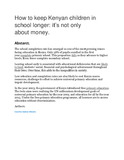| dc.contributor.author | Wekullo, Caroline Sabina | |
| dc.date.accessioned | 2021-12-15T08:36:11Z | |
| dc.date.available | 2021-12-15T08:36:11Z | |
| dc.date.issued | 2021-04-01 | |
| dc.identifier.uri | https://theconversation.com/how-to-keep-kenyan-children-in-school-longer-its-not-only-about-money-157461 | |
| dc.identifier.uri | http://ir-library.mmust.ac.ke:8080/xmlui/handle/123456789/1857 | |
| dc.description.abstract | The school completion rate has emerged as one of the most pressing issues facing education in Kenya. Only 58% of pupils enrolled in the first year complete primary school. This proportion falls as they advance to higher levels. Even fewer complete secondary school.
Leaving school early is associated with educational deficiencies that are likely to limit students’ social, financial and psychological achievement throughout their lives. Over time, this adds to the inequalities in society.
Low retention and completion rates are also likely to cost Kenya scarce resources, challenge its effort to achieve universal primary education and impair development.
In the year 2003, the government of Kenya introduced free primary education. The twin aims were realising the UN millennium development goals of universal primary education by the year 2005 and education for all by the year 2015. Under the free primary education programme, all learners are to access education without discrimination. | en_US |
| dc.language.iso | en | en_US |
| dc.publisher | Academic rigour, journalistic flair | en_US |
| dc.subject | Keep, Kenyan, children, school ,longer, money | en_US |
| dc.title | How to keep Kenyan children in school longer: it’s not only about money | en_US |
| dc.type | Article | en_US |

